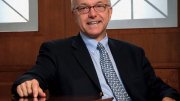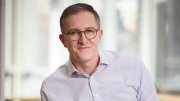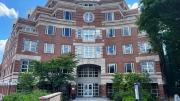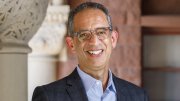Even as biomedical science is poised to deliver therapies and cures for countless diseases, “There has never been a greater disconnect between the remarkable opportunities” to achieve those goals “and the paucity of resources,” declared George Daley, dean of Harvard Medical School (HMS), in a November interview. Approaching his first decanal anniversary, he discussed his priorities for the school, focusing on the economic challenges facing medicine, from developing affordable treatments for patients to ensuring broad access to medical education—despite annual costs of more than $90,000 per student. In meeting these challenges, he envisions a “transformation of the academic medical center into a vehicle that is more effective at delivering treatments.” Realizing that vision entails reorganizing the teaching and research enterprise, revitalizing HMS’s campus, and expanding the ranks of scholarship-supported physician-scientists in its M.D.-Ph.D. program.
“Harvard Medical School has always been at the cutting edge of fundamental discovery research,” said Daley, who has himself made major contributions to the understanding of blood cancers and the use of stem-cell therapies (see harvardmag.com/specialized-stemcells-08). At the same time, “The pharmaceutical industry has been remarkably effective at delivering drugs: small molecules, antibodies, gene vectors, and now, at the vanguard, engineered cells. But the latest immunotherapy for cancer, the CAR T cell [personalized Chimeric Antigen Receptor therapy that stimulates a patient’s own immune system], is going to be priced at nearly half a million dollars a patient.” If other innovations come with similar price tags, he pointed out, this will quickly “bankrupt the system.” The drug-development and -approval pipeline—with timelines of 10 to 15 years and costs as high as $1.5 billion per drug—needs to operate much more rapidly, with significantly lower associated expenses, he said. “So we need to not only be innovative, but we need to be much more efficient: cheaper, faster, and better.”
HMS’s role, he continued, is to move fundamental discoveries forward to the point where the biopharmaceutical industry recognizes their value, and invests in them. “Where we have a common mission”—to develop therapies that will relieve suffering in patients—“that purpose drives us to work together,” he said. In a recent survey, three-quarters of the school’s faculty members said they are involved in research that could lead to new therapies. The primary roadblock they identified was lack of funding.
That is where Daley comes in. “When I started my lab,” in the mid 1990s, he recalled, “a senior mentor whispered in my ear, ‘If you control your funding, you control your future.’ And as a nascent dean, I’m feeling the same way. If I can provide this community with a wealth of resources that it deserves”—he currently spends a third of his time fundraising—“I will be able to make the community that much more effective.” That is true whether faculty members work with industry, or independently tackle a rare disease that could never attract commercial interest. HMS “will stay focused on the mission of advancing human knowledge, relieving suffering by developing new treatments,” Daley asserted. “If we are true to that mission, success will come on all angles”—including, ideally, “a stream of licensing and royalty revenues that should sustain the research enterprise into the future.”
Within HMS, being effective and efficient means rethinking how fields are organized. “Academic departments arose because of their responsibility for educating medical students,” Daley explained. Today, “Not all of them faithfully capture the dominant and emerging intellectual trends,” so a faculty-led reevaluation of departmental structures and goals is under way. The rapidly expanding fields of microbiology and immunobiology, for example, will become separate departments; other fields will be consolidated. And even though departments remain effective for pedagogical purposes, research may be better organized around shared resources, added the dean, such as expensive technologies like a new center for cryo-electron microscopy, which allows scientists to view individual molecules at near atomic resolution, and conversions of existing space to computational, “dry labs” for data scientists.
The tools of discovery are available, Daley continued, but “what we could do better is to organize those tools collectively around therapeutics-development programs.” He has convened a faculty task force, chaired by Sabbagh professor of systems biology Timothy Mitchison and professor of biological chemistry and molecular pharmacology Nathaniel Gray, to consider “innovative strategies for thinking about where therapeutics development will be 10 and 20 years from now. Harvard Medical School has to be a place that skates to where the puck is going to be,” he said.
Extending his analogy, his push to double, to 24, the number of fully funded physician-scientists in the M.D.-Ph.D. program, run jointly with MIT, might be considered a very efficient hat trick. It is a program he knows well (having been through it himself), attracting “some of the most ambitious and creative students,” who work at the intersection of discovery and clinical practice and are “disproportionately engaged in translational medicine.” The move, by slightly altering the composition of each incoming 165-member medical school class, will simultaneously enhance HMS’s effectiveness as a research institute, expand student access to medical education, and support a renewed commitment to diversifying the pipeline of faculty members, students, and scientific trainees.
By all accounts, the new dean is embracing his public role. He is working with MIT and Massachusetts governor Charlie Baker ’79—a former health-insurance CEO who “understands the medical marketplace”—on strategies for making the state friendly for data-science entrepreneurs. And he recently coauthored an article in The New England Journal of Medicine with dean of medical education Edward Hundert, together with their counterparts at Johns Hopkins and Stanford, on the pitfalls of merit-based financial aid, which can have the perverse effect of moving scarce scholarship funds from students with more financial need to those with less.
He is energized by the conviction that “biomedicine is likely to be, alongside renewable energy, one of the two great technological revolutions of the next 50 years.” Public-private partnerships have made U.S. biomedicine the envy of the globe, he said—“and there is no community on earth that rivals Cambridge and Boston’s density and strength” in that area. “As dean, I want to capitalize on that to make us even more effective. We have got the talent to do it. We have a responsibility to deliver.”









